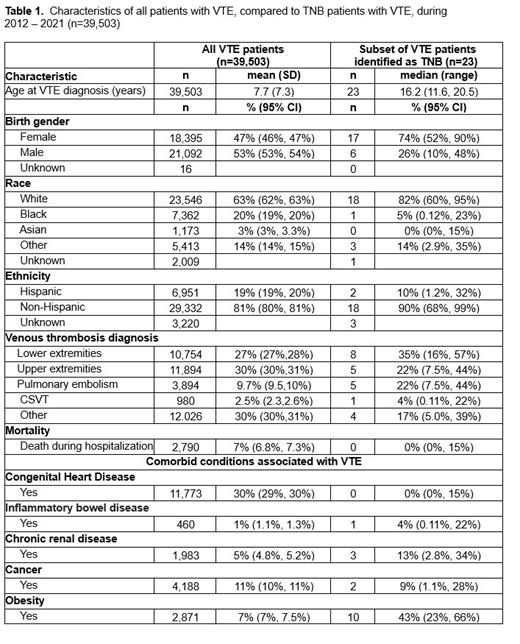Introduction
An increasing number of adolescents and youth identify as transgender or gender non-binary (TNB). Gender-affirming hormone treatment (GAHT), including estrogen or testosterone therapy increase appearance congruence and psychological functioning, and decrease depression, anxiety and suicidal ideation. In adult TNB patients, estrogen therapy is associated with an increased risk of venous thromboembolism (VTE), while the thromboembolic risk of testosterone is less clear. A recent cross-sectional study conducted at Boston Children's Hospital (BCH) suggested that VTE is rare in TNB adolescents and youth and typically occurs in the setting of additional risk factors. Additionally, GAHT was not identified as a significant risk factor for thrombosis in this cohort. Herein, we sought to confirm our preliminary findings across 49 free-standing children's hospitals using an administrative database.
Methods
The study was deemed exempt by the Institutional Review Board at BCH. Administrative approval was obtained through the Children's Hospital Association. Data for this study were obtained from Pediatric Health Information System (PHIS), an administrative database that contains clinical and resource utilization data from inpatient, ambulatory surgery, emergency department, and observation encounters across 49 tertiary-care children's hospitals in the United States. Data quality and reliability are assured through a joint effort between CHA and participating institutions. International Classification of Disease, 9 th and 10 th Editions (ICD9/ICD10) codes were used to identify eligible subjects, defined as children (from birth to 21 years of age) hospitalized with VTE between 1/1/2012-12/31/2021 at one of 49-participating hospitals. ICD9/ICD10 codes for gender dysphoria were used to identify TNB adolescents and youth. Mean (SD) or median (range) were calculated for continuous data, and frequency with 95% confidence interval for categorical data.
Results
During the study period, 39,503 unique patients (birth-assigned females: 18,395 [47%]) were diagnosed with VTE. Mean age (SD) at VTE diagnosis was 7.7 (7.3) years. Only 23 (0.06%) patients had an ICD9/ICD10 diagnosis code for gender dysphoria. Of these 23 patients, six (26%) were birth-assigned males and 17 (74%) were birth-assigned females. Among these 23 patients, the median (range) age at VTE diagnosis was 16.2 (11.6, 20.5) years. VTE location for patients identified as TNB included: lower extremities (n=8), upper extremities (n=5), pulmonary embolism (n=5), cerebral sinus venous thrombosis (CSVT) (n=1), and other (n=4). Demographic data for the overall cohort and the subset of TNB patients are summarized in Table 1. 2,790 patients with a VTE diagnosis died prior to hospital discharge, while none of the 23 VTE patients identified as TNB died prior to hospital discharge. Only 2/23 (8.7%) TNB patients with VTE had a diagnosis code for hormone replacement therapy (HRT). One patient was a birth-assigned male, and one was a birth-assigned female. Among the 23 TNB patients with VTE, none had congenital heart disease, ten (43%) were obese, three (13%) had chronic renal disease, two (9%) had cancer and one (4%) had inflammatory bowel disease (Table 1).
Discussion
These data support our initial observation that VTE is extremely rare in TNB adolescents and youth and typically occurs in the setting of additional risk factors for VTE including cancer, renal disease, obesity, and inflammatory bowel disease. Only 2/23 TNB patients had a simultaneous code for HRT, suggesting that HRT may not be a significant risk factor for VTE in this cohort. A limitation of this investigation is the inability to estimate how many TNB patients received care at the participating centers during the study period.
Disclosures
No relevant conflicts of interest to declare.


This feature is available to Subscribers Only
Sign In or Create an Account Close Modal